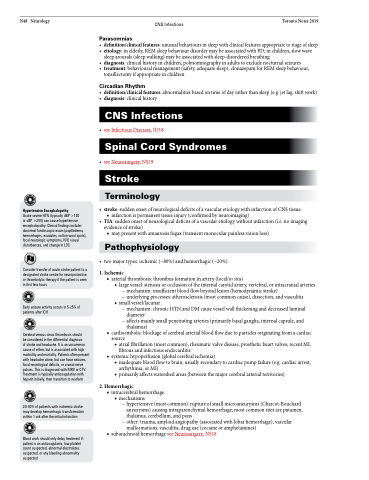Page 790 - TNFlipTest
P. 790
N48 Neurology
CNS Infections Toronto Notes 2019
Hypertension Encephalopathy
Acute severe HTN (typically dBP >130
or sBP >200) can cause hypertensive encephalopathy. Clinical findings include: abnormal fundoscopic exam (papilledema, hemorrhages, exudates, cotton-wool spots), focal neurologic symptoms, N/V, visual disturbances, and change in LOC
Consider transfer of acute stroke patient to a designated stroke centre for neuroprotective or thrombolytic therapy if the patient is seen in first few hours
Early seizure activity occurs in 5-25% of patients after ICH
Parasomnias
• definition/clinicalfeatures:unusualbehavioursinsleepwithclinicalfeaturesappropriatetostageofsleep
• etiology:inelderly,REMsleepbehaviourdisordermaybeassociatedwithPD;inchildren,slowwave
sleep arousals (sleep walking) may be associated with sleep-disordered breathing
• diagnosis:clinicalhistoryinchildren,polysomnographyinadultstoexcludenocturnalseizures
• treatment:behaviouralmanagement(safety,adequatesleep),clonazepamforREMsleepbehaviour,
tonsillectomy if appropriate in children
Circadian Rhythm
• definition/clinicalfeatures:abnormalitiesbasedontimeofdayratherthansleep(e.g.jetlag,shiftwork)
• diagnosis:clinicalhistory
CNS Infections
• seeInfectiousDiseases,ID18
Spinal Cord Syndromes
• seeNeurosurgery,NS29 Stroke
Terminology
• stroke:suddenonsetofneurologicaldeficitsofavascularetiologywithinfarctionofCNStissue ■ infarction is permanent tissue injury (confirmed by neuroimaging)
• TIA:suddenonsetofneurologicaldeficitsofavascularetiologywithoutinfarction(i.e.noimaging evidence of stroke)
■ may present with amaurosis fugax (transient monocular painless vision loss)
Pathophysiology
• twomajortypes:ischemic(~80%)andhemorrhagic(~20%)
1. Ischemic
■ arterial thrombosis: thrombus formation in artery (local/in situ)
◆ large vessel: stenosis or occlusion of the internal carotid artery, vertebral, or intracranial arteries
Cerebral venous sinus thrombosis should
be considered in the differential diagnosis
of stroke and headache. It is an uncommon cause of either, but is associated with high morbidity and mortality. Patients often present with headache alone, but can have seizures, focal neurological deficits, or cranial nerve palsies. This is diagnosed with MRV or CTV. Treatment is typically anticoagulation with heparin initially, then transition to warfarin
20-40% of patients with ischemic stroke may develop hemorrhagic transformation within 1 wk after the initial infarction
Blood work should only delay treatment if: patient is on anticoagulants, low platelet count suspected, abnormal electrolytes suspected, or any bleeding abnormality suspected
■ ■
– mechanism: insufficient blood flow beyond lesion (hemodynamic stroke)
– underlying processes: atherosclerosis (most common cause), dissection, and vasculitis ◆ small vessel/lacunar
– mechanism: chronic HTN and DM cause vessel wall thickening and decreased luminal diameter
– affects mainly small penetrating arteries (primarily basal ganglia, internal capsule, and thalamus)
cardioembolic: blockage of cerebral arterial blood flow due to particles originating from a cardiac source
◆ atrial fibrillation (most common), rheumatic valve disease, prosthetic heart valves, recent MI, fibrous and infectious endocarditis
systemic hypoperfusion (global cerebral ischemia)
◆ inadequate blood flow to brain, usually secondary to cardiac pump failure (e.g. cardiac arrest,
arrhythmia, or MI)
◆ primarily affects watershed areas (between the major cerebral arterial territories)
2. Hemorrhagic
■ intracerebral hemorrhage ◆ mechanisms
– hypertensive (most common): rupture of small microaneurysms (Charcot-Bouchard aneurysms) causing intraparenchymal hemorrhage; most common sites are putamen, thalamus, cerebellum, and pons
– other: trauma, amyloid angiopathy (associated with lobar hemorrhage), vascular malformations, vasculitis, drug use (cocaine or amphetamines)
■ subarachnoid hemorrhage see Neurosurgery, NS18


